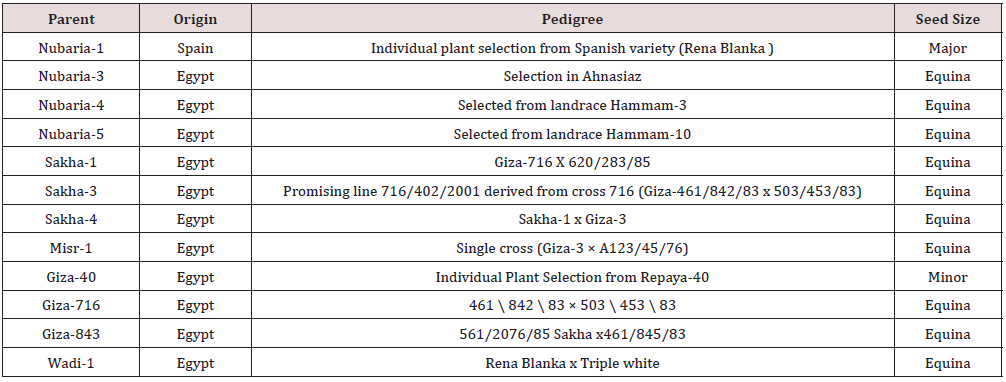
Lupine Publishers Group
Lupine Publishers
Menu
ISSN: 2637-4676
Research Article(ISSN: 2637-4676) 
Evaluation of Salinity Tolerance of Some Egyptian Faba Bean Varieties During the Germination Stage Volume 10 - Issue 1
Aya MA Bekhiet1, Ayman M Helmy2, Sara E Fouda2 and Clara R. Azzam1*
- 1Cell Research Department, Field Crops Research Institute, Agricultural Research Center, Giza 12619, Egypt
- 2Soil Science Department, Faculty of Agriculture, Zagazig University, El Sharqia Governorate, Egypt
Received: January 22, 2022; Published: January 31, 2022
Corresponding author: Clara R Azzam, Cell Research Department, Field Crops Research Institute, Agricultural Research Center, Giza 12619, Egypt
DOI: 10.32474/CIACR.2022.10.000326
Abstract
A germination laboratory experiment was conducted at Cell Research Department, FCRI, ARC to study the effect of different salinity levels 0, 1000, 3000, 5000, 7000, and 9000 mg L–1 NaCl on twelve faba bean varieties that were arranged in a CRBD in three replications. Results of ANOVA showed that the effect of variety, salt concentration, and their interactions were significant (LSD at the level of p <0.05) for the different germination parameters i.e. germination rate index (GRI), germination index (GI), germination velocity (GV), the last day of germination (LDG), the first day of germination (FDG), final germination % (FG%), time spread of germination (TSG), as well as, the relative salt damage rate (RSDR). The increase in salinity level led to a decrease in germination percentage in all varieties. Giza- 40 and Misr-1 varieties were the highest salinity tolerant varieties according to the RSDR% estimation. Increasing salinity concentration in up to 9000 NaCl mg L–1 retard germination percentage of Wadi-1, Sakha-1, and Sakha-3 varieties (0, 6.67, and 6.67 %, respectively), while Misr-1 and Nubaria-5 varieties were able to germinate under relatively high NaCl concentration (9000 mg L–1), their germination percentage recorded 80 and 66.67 %, respectively. According to the RSDR values, results suggested that faba bean varieties Misr-1 and Giza-40 could be recommended to grow under salt-affected soil, as those faba bean varieties were highly tolerant to salinity stress. In contrast, Sakha-1 variety is salt susceptible.
Keywords: Vicia faba L; abiotic stress; germination parameters
Introduction
Legumes (Leguminosae) are the third largest family of dicotyledons. Faba bean (Vicia faba L.) belongs to the Fabaceae family and has many public names. Legumes come second only to cereals in their importance to human beings (Graham and Vance [1]). Faba bean is the most important legumes crop cultivated in Egypt due to the affluence of seed protein content. Moreover, it is used for both human consumption and animal feed. The importance of faba bean in Egypt lies not only in its multiple uses in preparing diverse local dishes but also in its importance in crop rotation due to fixing atmospheric nitrogen that enriches the soil with nitrogen and organic matter and improving the water use efficiency of the cropping system (Pala et al., [2]). Several environmental factors adversely affect plant growth and development and the final yield performance of a crop. Drought and salinity, are among the major environmental constraints to crop productivity worldwide. Salinity is one of the most important environmental factors that severely affects crop production worldwide (Kumar et al., [3], El -Menshawi et al., [4], Keshta et al., [5], Ashraf and Foolad, 2013; Morsi et al., [6], Abdrabou et al., [7], Dobeie et al., [8], Ismael et al., [9,10], Azzam et al., [11,12] Abbas et al., [13]).
Seed germination is usually the most critical factor determining the success or failure of plant establishment. Initial species establishment in saline habitats depends on their seed germination response to thermal and saline regimes and it is the level of this response that usually determines whether a population can persist until reproductive maturity or not (Kader and Julzi, [14]). Germination is one of the most critical periods for a crop faced salinity stress. Germination failures on saline soils are often the result of high salt concentrations in the seed planting zone because of upward movement of soil solution and subsequent evaporation at the soil surface (Bernstein, [15]) and were negatively correlated by salinity stresses (Zhu [16]). Furthermore, screening for legumes that can grow and provide economic yield under saline conditions has a dual ecological benefit: (i) less nitrogen fertilization needed; (ii) ability to grow in a saline environment would reduce the effects of the saline irrigation water. Legumes are either salt susceptible or moderately salt tolerant. Vicia faba is moderately tolerant to salinity (Al–Tahir and Al–Abdulsalam, [17]). The weakened germination of seeds under salt stress might lead to uneven plant cover and a reduction in crop yield. Nevertheless, the salt response during germination can be manipulated as a reliable rapid test for the salt response of the plant. Generally, assessment of plant response to salinity is based on two parameters: the threshold, and the critical salinity levels. A large genetic variability has been recognized in V. faba in terms of seed size and composition in addition to tolerance to numerous biotic and abiotic stresses (Duc et al., [18]; Khoufi et al., [19]). More research is therefore needed to characterize the traits of different V. faba cultivars related to environmental adaptation and stress tolerance. Therefore, this study was conducted to explore the role of genotypic variability among twelve Egyptian V. faba cultivars concerning salt tolerance at the germination stage, as well as, to select the most salt-tolerant verities and the most susceptible ones.
Material and Methods
This study was carried out in the laboratories of Cell Research Department, Field Crops Research Institute, ARC. The combination between twelve faba bean varieties and six saltwater concentrations was arranged in a complete randomized block design in three replications. Table 1 shows the pedigree of the faba bean verities that were kindly obtained from Legume Crops Research Department, FCRI, ARC. Water salinity levels were 1000, 3000, 5000, 7000, and 9000 mg L-1 NaCl in addition to control treatment, i.e. distilled water.
Ten seeds of each faba bean variety were germinated in 15 cm Petri plates above Whatman filter paper with 10 ml of NaCl solution for each concentration and repeated 3 times. The plates were arranged at random in an incubator at 25±1°C for 14 days under a 16/8 hr’s light/dark photoperiodic regime (1000-Lux), till both the plumule and the radical were extended to more than 2 mm length. After 14 days, the germination percentage was calculated to estimate the salinity tolerance of each variety. Germination was determined using the international rules of seed testing (ISTA [20]). The germination indices correlated to seed vigor were evaluated such as:
-The First Day of Germination (day) (FDG): FDG=Day on which the first germination event occurred, according to Kader et al. [21].
-The Last Day of Germination (day) (LDG): LDG=Day on which the last germination event occurred, according to Kader et al. [21].
- Germination velocity (GV): percentage of seeds sprouted at the first count, 7 days after incubation, and was considered as an indicator for germination speed (Maguire, 1962).
-Time Spread of Germination (day) (TSG): The time in days between the first, and last germination events occurring in a seed lot, according to Kader et al. [22].
- Final Germination percent (%) (FG%): percentage of the normal seedling at the final day of counting (14 days after incubation) according to Scott et al. [23].
-Germination rate index (%/day) (GRI)): The GRI reflects the percentage of germination on each day of the germination period. According to Esechi (1994) after modification as follow:
GRI=G1/1 + G2/2 +· · ·+ Gx/x
G1=Germination percentage × 100 on the first day after sowing,
G2=Germination percentage × 100 on the second day after sowing
- Germination index (GI): In the GI, the maximum value is specified to the seeds germinated on the first day, and less to those germinated afterward. The lowest value would be for seeds germinated on the 10th day. Consequently, the GI underlines both the germination % and its speed. A higher GI value represents a higher percentage, and rate of germination. According to Bench et al. [24].
GI= (10×n1) + (9×n2) +· · · + (1×n10)
n1, n2 . . . n10 = No. of germinated seeds on the first, second, and subsequent days until the 10th day; 10, 9 . . ., and 1 are value specified to the number of germinated seeds on the first, second, and subsequent days, respectively.
- Relative salt damage rate (RSDR%): Evaluation of the tolerance of seeds to salt during germination was carried out as the protocol described by Chinese Crop Germplasm Resources. The salt tolerance was evaluated by RSDR, which was calculated according to Yang et al. [25] in the following formula
RSDR% = (GRc - GRt)/GRc.
While GRc represents the number of germinated seeds under control condition, and
GRt is the number of germinated seeds under salt treatment.
The salt tolerance can be classified into five rankings based on the RSDR, viz., high tolerance (RSDR < 20%), tolerance (20% ≤ RSDR < 40%), mediate tolerance (40% ≤ RSDR < 60%), sensitive (60% ≤ RSDR < 80%), high sensitive (RSDR ≥ 80%). All Data were exposed to proper statistical analysis of a completely randomized design (CRBD) and were subjected to two-factor of analysis of variance (ANOVA) as published by Gomez and Gomez (1984). The differences between treatment means were compared by LSD at the level of 0.05 by the use of MSTAT-C computer programs (Waller and Duncan, [26].
Results and discussions
The first day of germination (day) FDG
Data show that increasing of NaCl concentration from 0 up to 5000, 7000, and 9000 mg L–1 led to a significant increase in the first day of germination overall varieties; it recorded 3.3, 4.2, and, 4.7 days for the above-mentioned concentrations, respectively (Table 2). Lower FDG values indicate a faster initiation of germination Kader [27]). Similar results were reported by Wajid et al. [28] and Abayechaw and Wulchafo [29]. FDG varied significantly when NaCl concentration increased, at 9000 mg L–1 concentration. The Increasing salinity concentration in germination media often causes a delay in germination initiation (Abayechaw and Wulchafo, [29]). Giza-843 and Nubaria-5 varieties recorded the highest FDG being 11.0, and 8.33 days, respectively. While at free NaCl concentration, the FDG was after one day of cultivation in Giza-843 variety, as well as, Sakha-4 under 1000, and 3000 mg L–1 salt concentration, and Nubaria-4 under 1000 mg L–1 NaCl, whereas Nubaria-5 started its germination after 1 day under 3000 mg L–1 NaCl concentration. The different response of faba bean varieties to salinity was also reported by many researchers like Al–Tahir and Al–Abdulsalam (1997), who stated that the ability of seed germination of crop under salt stress conditions is an indication of salt tolerance of the crop, at least in the early stage of growth.
Table 2: Effect of six NaCl concentrations (0, 1000, 3000, 5000, 7000, and 9000 mgL–1) and their interaction on the first day of germination (FDG) of 12 faba bean varieties.
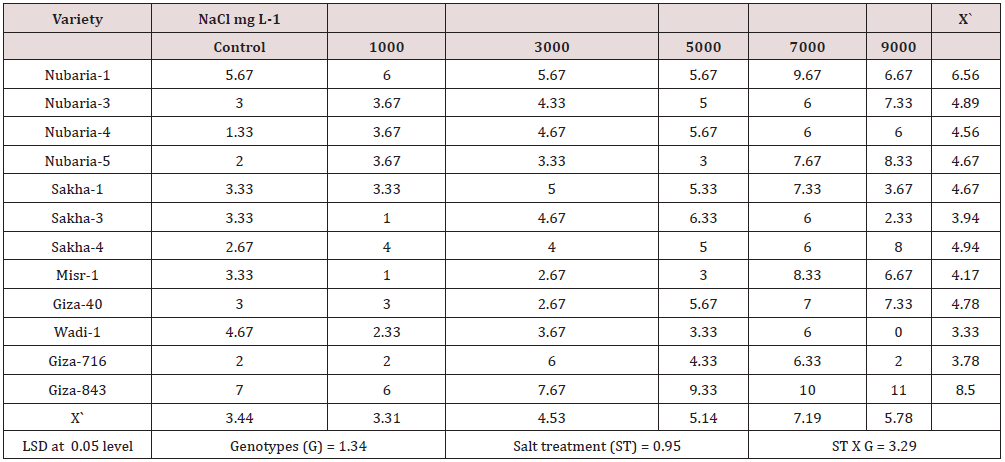
Germination velocity (GV %):
Germination velocity is considered an indicator of germination speed. Our results indicated that GV% significantly and generally decreased with each increase in NaCl concentration above 3000 mg L–1 (Table 3). The increase in salinity concentration of media solution above 3000 mg L–1 resulted in a marked decrease in germination velocity. The highest reduction of germination speed was recorded at 9000 mg L–1 NaCl concentration, as it recorded 8.33 %. Faba bean varieties differed significantly in overall salinity levels. Giza-40 and Sakha-4 varieties were faster in germination than others. They showed the highest value of GV%, which recorded 63.33 and 60.00 %, respectively. While the lowest GV% values were 16.67 and 32.22 % were recorded with Giza-843 and Sakha-1 varieties, respectively. Our results indicated that the reactions of faba bean varieties were significantly differed by increasing NaCl concentrations, but Junior (2018) reported that significant differences were not seen in the interaction effect of salinity and priming on the coefficient of velocity. The GV% varied significantly when NaCl concentration increased under 1000 mg L–1 NaCl concentration. Wadi-1 and Giza-40 recorded the highest GV% that equal to 100 and 100 %, respectively, while Sakha-3, Misr-1, and Giza-40 recorded the highest value of GV% under 3000 mg L–1 NaCl concentration, it recorded 93.33, 93.33, and 93.33 %, respectively. On the other hand, Nubaria-1, Sakha-1, Wadi-1 and Giza-843 recorded 0 % under 9000 mg L–1 NaCl concentration. The Increasing salinity concentration in germination media often causes a delay in germination initiation (Abayechaw and Wulchafo [29] ). This means that high levels of NaCl not only decreased germination percentage but also delayed seed germination.
Table 3: Effect of six NaCl concentrations (0, 1000, 3000, 5000, 7000, and 9000 mgL–1) and their interaction on germination velocity (GV%) of 12 faba bean varieties.
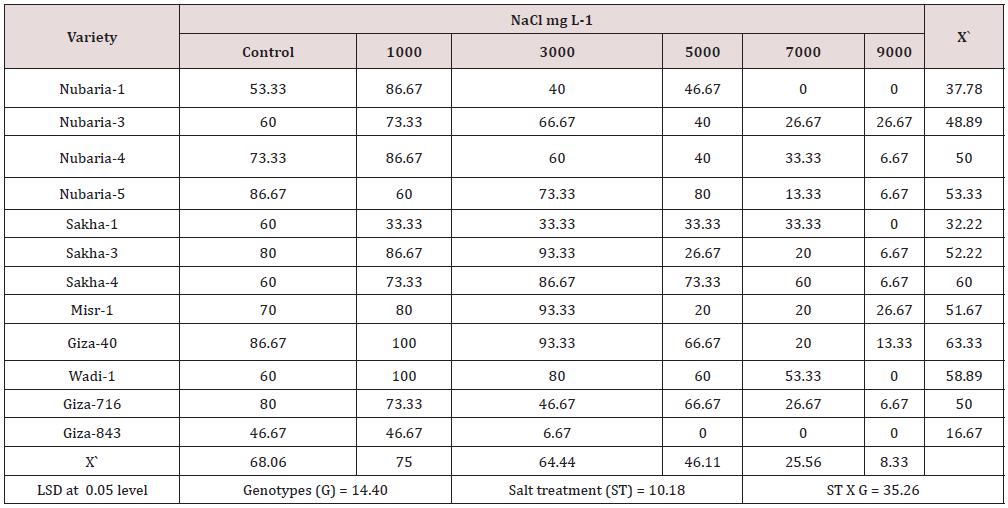
The last day of germination (day) LDG
Data show that increasing NaCl concentration from 0 up to 1000, 3000, and 9000 mg L–1 led to a significant decrease of LDG overall varieties; it recorded 10.11, 7.31, 7.92, and 7.25 days for the abovementioned concentrations, respectively (Table 4). Similar results were reported by Wajid et al. [28] and Abayechaw and Wulchafo [29]). Kader (2005) reported that lower LDG values indicate a faster ending of germination. LDG among the most faba bean varieties overall NaCl concentrations was significant. The varieties differed in their response to salt stress and the effect can easily be observed. The highest value of LDG was recorded with Giza-843, and Nubaria-3, it recorded 10.39, and 9.78 days respectively. While Wadi-1 and Sakha-3 recorded the lowest last day of germination value it recorded 6.50, and 7.06 days respectively. Our results indicated that the reactions of faba bean varieties were significantly differed by increasing NaCl concentrations. The highest last day of germination was recorded 12 days for Nubaria-1 and Nubaria-3 under control condition free of salt, while also, Misr-1 (under 7000 mg L–1) ended their germination after 12 days of cultivation Wadi-1 and Giza-716 terminated their germination after 0, and 2 days, respectively. The different response of faba bean varieties to salinity was also reported by many researchers such as Al–Tahir and Al–Abdulsalam (1997), who stated that the ability of seed germination of crop under salt stress conditions is an indication of salt tolerance of the crop, at least in the early stage of growth.
Table 4: Effect of six NaCl concentrations (0, 1000, 3000, 5000, 7000, and 9000 mg L–1) and their interaction on the last day of germination (LDG) of 12 faba bean varieties.
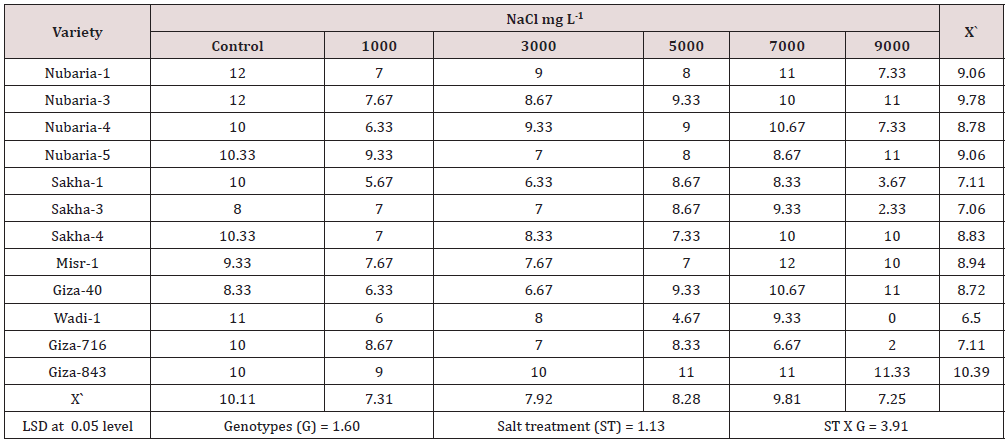
Time spread of germination (day) TSG
The higher the TSG value, the greater the difference in germination speed between the ‘fast’ and ‘slow’ germinating members of a seed lot (Kader, 2005). Means of TSG of faba bean as affected by NaCl concentrations are presented in Table 5. Data show that increasing NaCl concentration from 0 up to 1000, 3000, 5000, 7000, and 9000 mg L–1 led to a significant decrease in TSG overall varieties; it recorded 6.70, 4.00, 3.39, 3.14, 2.61, and 1.47 for the above-mentioned concentrations, respectively. Such harmful effect of NaCl salinity may be due to the toxic effect of accumulated ions of this salt on the embryonic activity. Similar results were reported by Ahmad and Sharma [30] and EL-Katony et al. [31]. TSG among the most faba bean varieties (overall NaCl concentrations) was highly significant. The varieties differed in their response to salt stress and the effect can easily be observed. The highest TSG was recorded with Nubaria-3, and Misr-1, it recorded 4.89, and 4.78 days, respectively. While Giza-843 and Sakha-1 recorded the lowest time spread of germination, they recorded 1.89, and 2.44 days, respectively. Our results indicated that the reactions of faba bean varieties were significantly differed by increasing NaCl concentrations. Nubaria-3 and Nubaria-4 recorded the highest time spread of germination, it recorded 9.00, and 9.00 days under the control treatment conditions (Free of NaCl). Meanwhile, Sakha-1, Sakha-3, Wadi-1, and Giza-716 varieties recorded the lowest TSG being 0, 0, 0, and 0 days under the salt concentration of 9000 NaCl mg L–1, respectively. Our results are in harmony with those obtained by EL-Katony et al. [31].
Table 5: Effect of six NaCl concentrations (0, 1000, 3000, 5000, 7000, and 9000 mgL–1) and their interaction on time spread of germination (TSG) of 12 faba bean varieties.
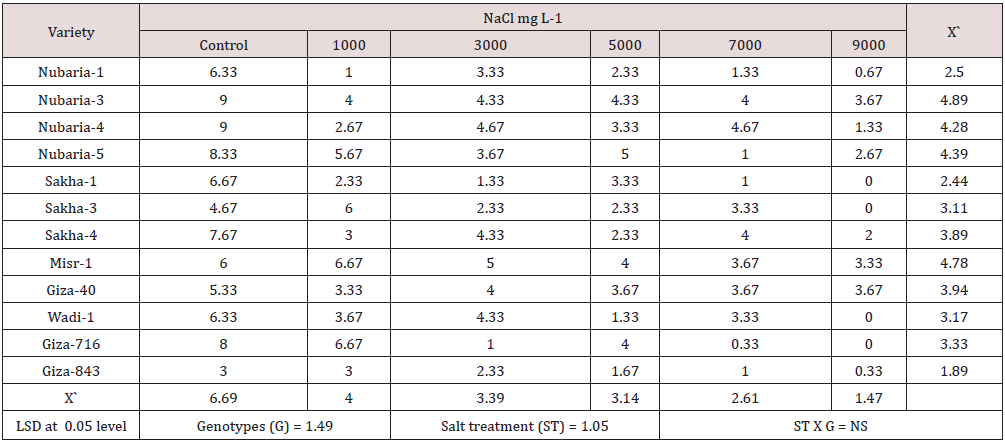
Final germination % (FG%):
Final germination % only reflects the final percentage of germination attained and provides no picture of the speed or uniformity of germination. The higher the FG% value the greater the germination of a seed population. Means of the FG% of faba bean as affected by NaCl concentrations are presented in Table 6. Data show that increasing of NaCl concentration from 0 up to 1000, 3000, 5000, 7000, and 9000 mg L–1 led to a significant decrease in germination percentages overall varieties; it recorded 100, 87.22, 86.11, 76.67, 68.89, and 33.89 % for the above-mentioned concentrations, respectively. Such harmful effect of NaCl salinity may be due to the toxic effect of accumulated ions of this salt on the embryonic activity. Similar results were reported by Ahmad and Sharma [30] and EL-Katony et al. [31]. The FG% among the most faba bean varieties (overall NaCl concentrations) was highly significant. The varieties differed in their response to salt stress and the effect can easily be observed. The highest FG% was recorded with Giza-40, and Misr-1, it recorded 87.78, and 85.56 %, respectively. While Sakha-1 and Giza-716 recorded the lowest final germination percentage, they recorded 50.00, and 61.11 %, respectively.
Table 6: Effect of six NaCl concentrations (0, 1000, 3000, 5000, 7000, and 9000 mgL–1) and their interaction on final germination percent (FG %) of 12 faba bean varieties.
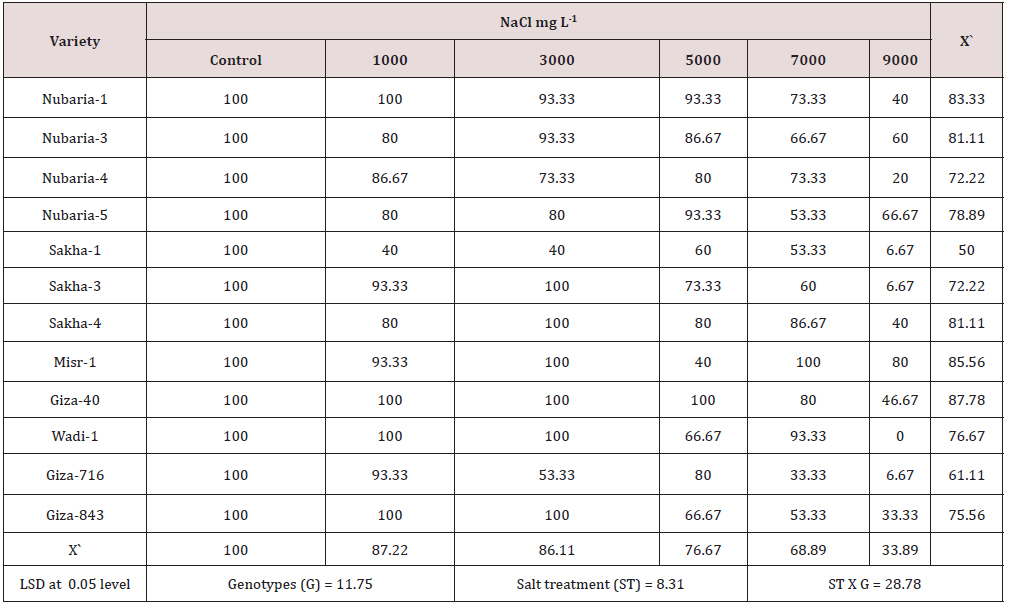
Our results indicated that the reactions of faba bean varieties were significantly differed by increasing NaCl concentrations. The FG% of all varieties was 100 % under the control treatment conditions (Free of NaCl). However, it varied significantly when NaCl concentration increased, at 9000 mg L–1 concentration. Wadi-1, Sakha-1, Sakha-3, and Giza-716 varieties recorded the lowest germination percentages being 0.00, 6.67, 6.67, and 6.67 % respectively. Increasing salinity concentration in germination media often causes osmotic and/or specific toxicity that may decrease or retard germination % (Munns and Tester [32]). Misr-1 and Nubaria-5 varieties were able to germinate under relatively high NaCl concentration (9000 mg L–1), their germination percentage recorded 80.00 and 66.67 %, respectively. The different response of faba bean varieties to salinity was also reported by many researchers such as Al–Tahir and Al–Abdulsalam [17] stated also that the ability of seed germination of crop under salt stress conditions is an indication of salt tolerance of the crop, at least in the early stage of growth.
Germination index (GI)
The GI appears to be the most comprehensive measurement parameter combining both germination percentage and speed (spread, duration, and ‘high/low’ events). It magnifies the variation among seed lots in this regard with an easily compared numerical measurement. In the GI, maximum weight is given to the seeds germinated on the first day and less to those germinated afterward.
The lowest weight would be for seeds germinated on the 10th day. Thus, the GI highlights both the germination% and its speed. A higher GI value signifies a higher percentage and degree of germination Kader [27]. Our results reveal that salinity concentrations significantly affected GI Table 7. Data show that an increase of NaCl concentration from1000 up to 3000, 5000, 7000, and 9000 mg L–1 led to a significant decrease in germination percentages overall varieties; it recorded 328.33, 256.56, 181.28, 99.83, and 34.06 for the above-mentioned concentrations, respectively. The highest GI was recorded with Giza-4, and Wadi-1, it recorded 260.00, and 232.44, respectively. While Giza-843 and Sakha-1 recorded the lowest germination index, they recorded 83.44, and 141.22, respectively. Each increase in salinity concentration was associated with a marked decrease in germination index. Our results indicated that the reactions of faba bean varieties were significantly differed by increasing NaCl concentrations. The highest values recorded by Wadi-1, and Giza-716, as it recorded 448.00, and 428.00 (under 1000 mg L–1), while Wadi-1 and Sakha-1 recorded the lowest values, it recorded 0.00, and 2.00 (under 9000 mg L–1), respectively. Similar observations were reported by Mass and Hoffman [33], Puppala et al. [34], and Houle et al. [35]. Seed germination at 9000 mg L–1 NaCl and more was substantially delayed. It was quite probable that the delay and reduction in seed germination under these circumstances were equivalently due to osmotic or toxicity effects or a combination of both.
Table 7: Effect of six NaCl concentrations (0, 1000, 3000, 5000, 7000, and 9000 mgL–1) and their interaction on germination index (GI) of 12 faba bean varieties.
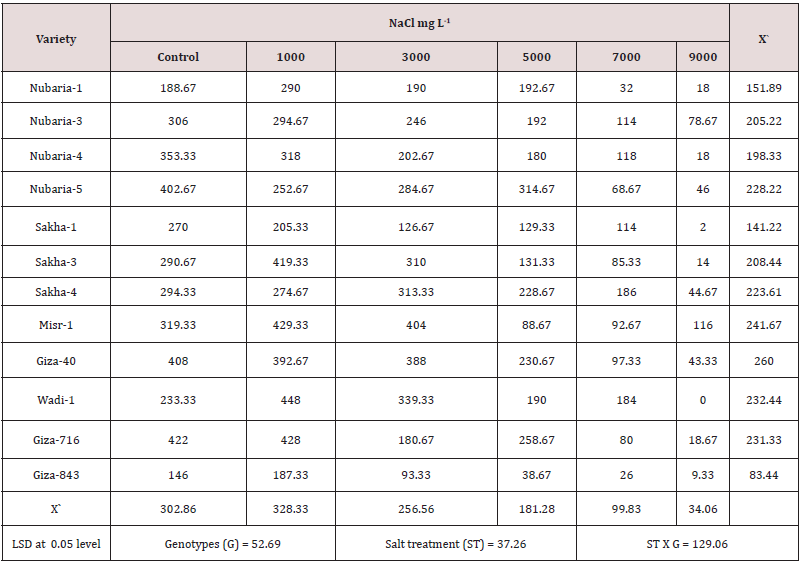
Germination rate index (%/day) GRI
GRI calculations simply show the germination% per day, so the higher the percentage and the shorter the duration, the higher the GRI. This parameter lacks any correlation with the ‘high’ and ‘low’ germination days as it spreads the percentage evenly across the time spread. The GRI reflects the percentage of germination on each day of the germination period. Higher GRI values specify higher and faster germination (Kader[22]). Means of GRI of faba bean as affected by NaCl concentrations are presented in Table 8. Data show that increasing NaCl concentration from 0 up to 1000, 3000, 5000, 7000, and 9000 mg L–1 led to a significant decrease in GRI overall varieties; it recorded 21.69, 25.10, 16.59, 12.30, 8.46, and 3.77 % for the above-mentioned concentrations, respectively. Such harmful effect of NaCl salinity may be due to the toxic effect of accumulated ions of this salt on the embryonic activity. Similar results were reported by Ahmad and Sharma [30] and EL-Katony et al. [36]. The GRI among the most faba bean varieties (overall NaCl concentrations) was highly significant. The varieties differed in their response to salt stress and the effect can easily be observed. The highest GRI was recorded with Giza-40, and Misr-1, it recorded 19.39, and 18.66 %, respectively. Where as, Giza-843 and Sakha-1 recorded the lowest GRI, 8.67, and 10.34 %, respectively.
Table 8: Effect of six NaCl concentrations (0, 1000, 3000, 5000, 7000, and 9000 mgL–1) and their interaction on germination rate index (GRI %) of 12 faba bean varieties.
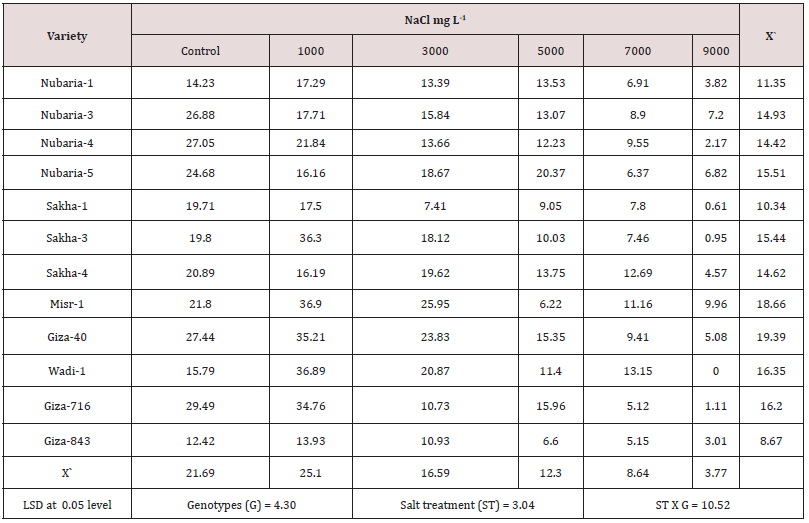
Our results indicated that the reactions of faba bean varieties were significantly differed by increasing NaCl concentrations. The highest GRI was recorded with Misr-1 and Wadi-1, it recorded 36.90 and 36.89, respectively (under 1000 mgL–1). While, Wadi-1 and Sakha-1 varieties recorded the lowest GRI, 0.00 and 0.61 % respectively (under 9000 mgL–1). Increasing salinity concentration in germination media often causes osmotic and/or specific toxicity that may reduce or retard germination percentage (Munns and Tester [32]). The different response of faba bean varieties to salinity was also reported by many researchers such as Al–Tahir and Al– Abdulsalam [17] stated also that the ability of seed germination of crop under salt stress conditions is an indication of salt tolerance of the crop, at least in the early stage of growth.
Relative salt damage rate (RSDR %):
Data show that increasing NaCl concentration from 1000 up to 3000, 5000, 7000, and 9000 mg L–1 led to a significant decrease in RSDR% overall varieties; it recorded 12.8, 13.9, 23.3, 31.1, and 66.1 % for the above-mentioned concentrations, respectively. Such harmful effect of NaCl salinity may be due to the toxic effect of accumulated ions of this salt on the embryonic activity Similar results were reported by Ahmad and Sharma [30] and EL-Katony et al. [36-38]. The FG% among the most faba bean varieties (overall NaCl concentrations) was highly significant. The varieties differed in their response to salt stress and the effect can easily be observed in Table 9 and Figure 1. The highest RSDR was recorded with Giza- 40, and Misr-1, it recorded 14.7, and 17.3 %, respectively. While Sakha-1 and Giza-716 recorded the lowest RSDR, they recorded 60.0, and 46.7 %, respectively. High tolerant variety (RSDR < 20%), tolerant variety (20% ≤ RSDR < 40%), mediate tolerant variety (40% ≤ RSDR < 60%), susceptible variety (60% ≤ RSDR < 80%), high susceptible variety (RSDR ≥ 80%).
Figure 1: The response of twelve faba bean varieties against six different NaCl concentrations: 0, 1000, 3000, 5000, 7000, and 9000 mgL–1 in Lab experiment.

Table 9: Effect of six NaCl concentrations (0, 1000, 3000, 5000, 7000, and 9000 mgL–1) and their interaction on relative salt damage rate (RSDR %) of 12 Faba bean varieties.
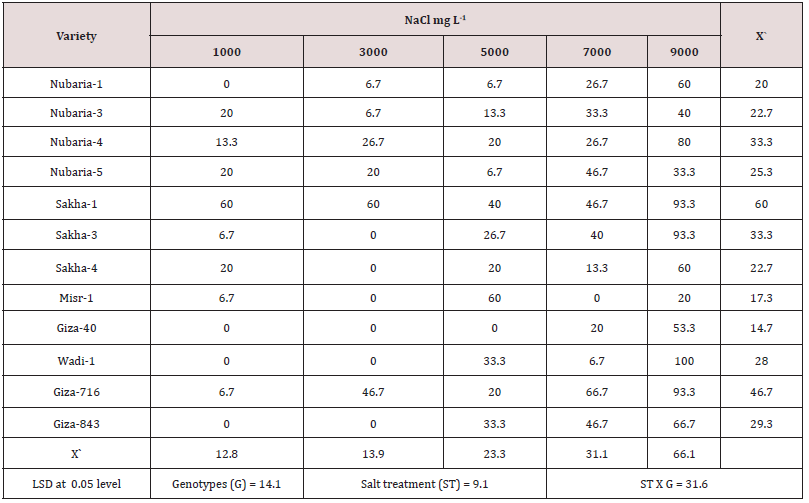
Our results indicated that the reactions of faba bean varieties were significantly differed by increasing NaCl concentrations. The RSDR of almost all varieties was about 100% under control. However, it varied significantly when NaCl concentration increased, at 7000 mg L–1 concentration. Misr-1 variety recorded the highest RSDR being 0 %. Increasing salinity concentration in germination media often causes osmotic and/or specific toxicity that may reduce or retard germination percentage (Munns and Tester[32]). Our results reveal that there were significant differences among the twelve evaluated faba bean varieties in RSDR. The highest RSDR was observed Giza-40, and Misr-1 varieties have markedly surpassed all varieties, their germination rates were 14.7 % and, 17.3 %, respectively. Meanwhile, Sakha-1 and Giza-716 gave the lowest values in germination rate, it recorded 60.0 %, and 46.7 %, respectively. The interaction between faba bean varieties and NaCl concentrations had a significant effect on the RSDR. Data show that the highest reduction was observed when salinity concentration was increased (9000 mg L–1 NaCl). The germination rate of all evaluated faba bean varieties significantly varied in response to salinity concentrations. Wadi-1, Sakha-1, Sakha-3, and Giza-716 have surpassed all other varieties in germination rate under the highest salinity concentration. They recorded 100.0, 93.3, 93.3, and 93.3 %, respectively. Meanwhile, Misr-1 variety was the lowest in this concern. It recorded 0 %. Other interactions were insignificant on germination rate.
Changes % in different growth parameters in 12 faba bean varieties due to salt stress with 6 NaCl concentrations are shown in Table 10. Three color scale heat map, yellow as the midpoint of parameters values compared to control, red for changes above control values, and blue for changes below control values. At all faba bean varieties, the change % increased significantly while increasing salinity levels of NaCl, the lowest values in almost all varieties were noted in 7000 and 9000 mg L–1 of NaCl. In general increasing salinity levels led to a significant decreasing in different growth parameters.
Table 10: Changes % in different growth parameters in 12 faba bean varieties due to salt stress with 6 NaCl concentrations. Three color scale heat map, yellow as the midpoint of parameters values compared to control, red for changes above control values, and blue for changes below control values.
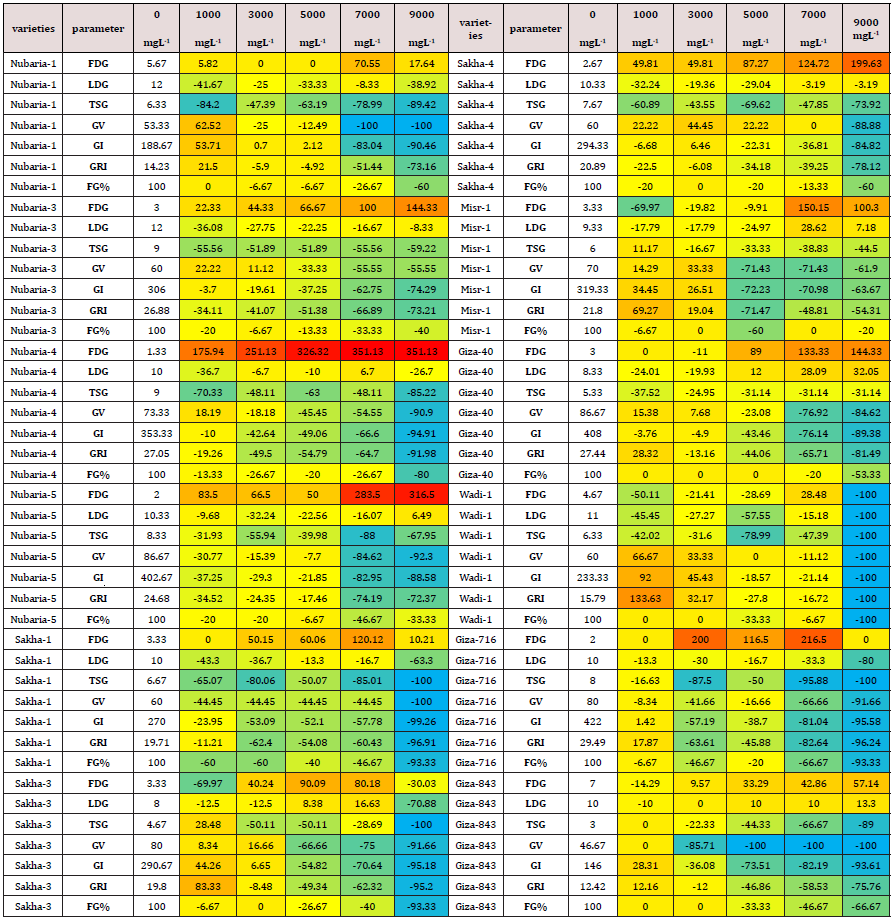
Conclusion
Our findings confirmed that germination percentage, germination velocity, and germination rate, as well as, all other germination parameters were significantly affected by all concentrations of NaCl (1000, 3000, 5000, 7000, and 9000 mgL- 1). All studied traits were decreased with increasing salinity concentrations beyond 1000 mg L–1 NaCl, with a sharp drop at 7000 mg L–1 NaCl concentration and preventing germination of faba bean seeds at the concentration of 9000 mg L–1 NaCl. We could conclude that all faba bean varieties were affected significantly by the high salt concentrations. Misr-1 and Giza-40 varieties markedly surpassed all varieties concerning FG%, GI, GRI traits; meanwhile, Giza-40 variety markedly surpassed all varieties concerning germination velocity trait, while, Giza-843 variety markedly surpassed all varieties concerning FDG and LDG. Whereas, Nubaria-3 markedly surpassed all varieties concerning TSG. According to the RSDR values, results suggested that faba bean varieties Misr-1 and Giza- 40 could be recommended to grow under salt-affected soil, as those faba bean varieties were highly tolerant to salinity stress. In contrast, Sakha-1 variety is salt susceptible, meanwhile, Giza-716 could be considered as a mediate tolerant variety.
References
- Graham PH, Vance CP (2003) Legumes: importance and constraints to greater use. Plant Physiol 13: 872–877.
- Pala M, Armstrong E, Johansen C (2000) The role of legumes in sustainable cereal production in rainfed areas. Linking research marketing opportunities for pulses in the 21st century. In: Knight, R.(Ed.), Proceedings of the Third International Food Legumes Research Conference, 22-26 September 1997, Adelaide, Australia, Current Plant Science and Biotechnology in Agriculture, vol. 34. Kluwer Academic Publishers, pp: 323-334.
- Kumar V, Shriram V, Jawali N, Shitole MG (2007) Differential response of indica rice genotypes to NaCl stress in relation to physiological and biochemical parameters. Arch Agron Soil Sci 53(5): 581–592.
- El-Menshawi, Mervat M, Ashry, Naglaa A, Azzam, et al. (2003) Evaluation of some grain sorghum hybrids under saline conditions and identification of salinity tolerant genotypes using some biochemical genetic markers. Egyptian Journal of Plant Breeding 7(2): 183-203.
- Keshta MM A, Hassan Nemat M, Azzam Clara R, Hassanin Olfet S (2011) Embryogenic callus induction of some sunflower (Helianthus annuus L.) genotypes under in vitro salt stress. J Plant Production, Mansoura Univ 2(2): 327-333.
- Morsi Nahid AA, El-Habbal MS, Abdrabou RT, Fergany MA E H, Azzam Clara R (2015) Evaluation of salinity tolerance of twenty-two canola varieties during germination stage. J Biol Chem Environ Sci 10(2): 309-322.
- Abdrabou R Th, Fergany MAH, Azzam, Clara R, Morsi Nahid AA (2017) Devolopment of Some Canola Genotypes to Salinity Tolerance using Tissue Culture Technique J Agron 39(3): 431-448.
- Dobeie AM, Abbas MS, Soliman A Sh, Azzam, Clara R (2017) In vitro screening of some Egyptian and Nigerian peanut genotypes for salt tolerance. Egypt. J Plant Breed 21(6): 1035-1050.
- Ismael, Rabab R, Omar MNA, Azzam, Clara R Ahmad, et al. (2018a) Characterization and evaluation of rhizobium isolates from vicia faba for some plant growth promoting traits. Bioscience Research 15(4): 2971-2982.
- Ismael, Rabab R, Ahmad Enas S, Abdel- Fattah M, Clara R, Zahran HH, et al. (2018b) Effect of plant growth-promoting rhizobacteria (PGPR) on growth and symbiotic nitrogen fixation of vicia faba plants under salt stress. Plant Science Journal 7(1): 01-19.
- Azzam, Clara R, Abd El Naby, Zainab M, Mohamed NA (2019) Salt Tolerance Associated with Molecular Markers In Alfalfa. Journal of Bioscience and Applied Research 5(4): 416 -428.
- Azzam, Clara R, Al-Taweel S, Abdel-Aziz, Ranya M, et al. (2021) Salinity Effects on Gene Expression, Morphological, and Physio-Biochemical Responses of Stevia rebaudiana Bertoni In Vitro. Plants 10(4): 820.
- Abbas MS, Dobeie Amany M, Azzam Clara R, Soliman, Amira Sh (2021) Identification of salt tolerant Genotypes among Egyptian and Nigerian Peanut (Arachis hypogaea L.) Using Biochemical and Molecular Tools. Part of the Springer Water book series (SPWA). Springer International Publishing AG Book entitled "Mitigating Environmental Stresses for Agricultural Sustainability in Egypt" Part IV: Advanced procedures in improving crop productivity: 437-469.
- Kader MA, Julzi SC (2004) Effects of thermal and salt treatments during imbibition on germination and seedling growth of sorghum at 42/19oC J Agron. Crop Sci 190: 35-38.
- Bernstein L (1974) Crop growth and salinity. In: J. Van Schiffgaarde (ed.), Drainage for agriculture. Agron. Monogr 17 ASA, Madison, WI, P. 39-54.
- Zhu JK (2001) plant salt tolerance. Trends in Plant Sci 6: 66-71.
- Al Tahir OA, Al–Abdulsalam MA (1997) Growth of faba bean (Vicia faba L.) as influenced by irrigation water salinity and time of salinization. Agric Water Manage 34: 161–167.
- Duc G, Bao S, Baum M, Redden B, Sadiki M, et al. (2010) Diversity maintenance and use of Vicia faba L. genetic resources. Field Crops Res115: 270–278.
- Khoufi S, Khamassi K, Teixeira da Silva JA, Aoun N, Rezgui S, Ben Jeddi F (2013) Assessment of diversity of phenologically and morphologically related traits among adapted populations of sunflower (Helianthus annuus L.). Helia 36: 29-40.
- ISTA, International Seed Testing Association (1993) International rules for seed testing. Seed Sci. and Technol 21: 1-150.
- Kader M, Omari M, Hattar B (1998) Maximizing germination percentage and speed of four Australian indigenous tree species. Dirasat Agricultural Sciences 25: 157-169.
- Maguire JD (1962) Seed of germination – aid in selection and evaluation for seedling emergence and vigour. J Crop Science 2(2): 176-177.
- Scott S, Jones R, Williams W (1984) Review of data analysis methods for seed germination. Crop Science 24: 1192–1199.
- Bench AR, Fenner, M, Edwards P (1991) Changes in germinability, ABA content and ABA embryonic sensitivity in developing seeds of Sorghum bicolor (L.) Moench induced by water stress during grain filling. New Phytologist118: 339–347.
- Yang F, Chen H, Liu C, Li L, Liu L, et al. (2020) Transcriptome profile analysis of two Vicia faba cultivars with contrasting salinity tolerance during seed germination. Scientific Reports 10: 7250.
- Waller RA, Duncan DB (1969) A bayes rule for the symmetric multiple comparisons problem. J Am Stat Assoc 64(1): 484-1503.
- Kader MA (2005) A Comparison of Seed Germination Calculation Formulae and the Associated Interpretation of Resulting Data. Journal & Proceedings of the Royal Society of New South Wales138: 65-75.
- Wajid HA, Alderfasi AA, Afzal I, Junaid MB, Mahmood A, et al. (2018) Evaluating the potential effect of seed Priming techniques in improving Germination and root shoot length of Maize seed. Sciendo J LI 2(174): 5-15.
- Abayechaw D, Wulchafo K (2020) Germination Test and Seed Rate Determination on Pulse Crops. Int. J Curr Res Aca Rev 8(5): 113-123.
- Ahmad P, Sharma S (2008) Salt stress and phyto-biochemical responses of plants. Plant Soil Environ 54: 89–99.
- EL-Katony TM, Khedr AA, Soliman NG (2015) Nutrients alleviate the deleterious effect of salinity on germination and early seedling growth of the psammophytic grass Elymus farctus. Botany 93: 559-571.
- Munns R, Tester M (2008) Mechanisms of salinity tolerance. Annu Rev Plant Biol 59: 651–681.
- Mass EV, Hoffman GJ (1977) Crop salt tolerance: Current assessment. J Irrig Drainage Div, Am Soc Civ Eng 103: 115–134.
- Puppala NL, Fowler J, Poindexter L, Bhardwaj HL (1999) Evaluation of salinity tolerance of canola germination. In: J Janick (ed.), Perspectives on new crops and new uses. ASHS Press, Alexandria, VA p. 251–253.
- Houle G, Morel L, Reynolds CE, SiegelJ (2001) The effect of salinity on different developmental stages of an endemic annual plant, Aster laurentianus (Asteraceae). American Journal of Botany 88(1): 62-67.
- Esechie H (1994) Interaction of salinity and temperature on the germination of sorghum. Journal of Agronomy and Crop Science172: 194-199.
- Gomez KA and Gomez AA (1984) Statistical procedures for agricultural research. John Wiley and Sons, Inc. New York.
- Junior EA (2018) Effect of seed priming on germination and seedling development of pepper under salinity stress. MSc thesis, University of Ghana.

Top Editors
-

Mark E Smith
Bio chemistry
University of Texas Medical Branch, USA -

Lawrence A Presley
Department of Criminal Justice
Liberty University, USA -

Thomas W Miller
Department of Psychiatry
University of Kentucky, USA -

Gjumrakch Aliev
Department of Medicine
Gally International Biomedical Research & Consulting LLC, USA -

Christopher Bryant
Department of Urbanisation and Agricultural
Montreal university, USA -

Robert William Frare
Oral & Maxillofacial Pathology
New York University, USA -

Rudolph Modesto Navari
Gastroenterology and Hepatology
University of Alabama, UK -

Andrew Hague
Department of Medicine
Universities of Bradford, UK -

George Gregory Buttigieg
Maltese College of Obstetrics and Gynaecology, Europe -

Chen-Hsiung Yeh
Oncology
Circulogene Theranostics, England -
.png)
Emilio Bucio-Carrillo
Radiation Chemistry
National University of Mexico, USA -
.jpg)
Casey J Grenier
Analytical Chemistry
Wentworth Institute of Technology, USA -
Hany Atalah
Minimally Invasive Surgery
Mercer University school of Medicine, USA -

Abu-Hussein Muhamad
Pediatric Dentistry
University of Athens , Greece

The annual scholar awards from Lupine Publishers honor a selected number Read More...




